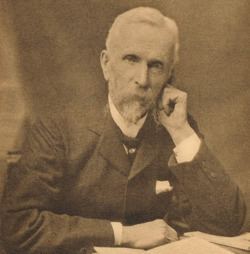Nationality Scottish Role Physicist | Name John Aitken Alma mater Glasgow University | |
 | ||
Notable awards Keith Prize 1883-5Gunning Victoria Jubilee Prize 1893-6Royal Medal (1917) Died November 14, 1919, Falkirk, United Kingdom | ||
John Aitken, FRS, FRSE (18 September 1839 – 14 November 1919) was a Scottish meteorologist, physicist and marine engineer. He was one of the founders of cloud physics and aerosol science, who built the first apparatus to measure the number of dust and fog particles in the atmosphere, a koniscope.
Contents
Biography
Aitken was born in Falkirk on 18 September 1839, the son of Henry Aitken of Darroch, a Falkirk lawyer.
He was educated at Falkirk Grammar School and studied marine engineering at Glasgow University, undertaking his engineer training with Messrs Napier & Sons, the Glasgow shipbuilder.
He settled at Falkirk, where he carried out his various experiments. He was elected a Fellow of the Royal Society in 1889 and was awarded the Royal Medal in 1917. He also received the Keith Medal (1886) and Gunning Prize (1897) from the Royal Society of Edinburgh. In April 1902 he received an honorary doctorate (LL.D.) from the University of Glasgow.
The Royal Society of Edinburgh awarded him the Keith Medal 1883-5.
He died at Ardenlea in Falkirk 13 November 1919.
Work
He carried out experiments on atmospheric dust in relation to the formation of clouds and mists (1882), on the formation of dew (1885) and on the laws of cyclones (1891). His instrument for counting the dust particles in the air has been used in principle by many later workers. He also invented new forms of thermometer screens which aided the development of meteorology.
One of his experiments conducted with a self-designed apparatus provided the first evidence of new particle formation in the atmosphere. This work was documented in an article titled "On some nuclei of cloudy condensation", in the 39th volume of the Transactions of the Royal Society of Edinburgh published in 1898.
John Aitken was the author of a number of important pioneering discoveries "On Dust, Fogs and Clouds" (the title of an 1880 article he penned). As early as 1874, Aitken had concluded that when water vapour in the atmosphere condenses, it must condense on some solid particle, and thus, without the presence of dust and other aerosol particles in the air, there would be no formation of fog, clouds, or rain. In 1884, he concluded that the brilliant colours often seen in the sunset are due to the refraction of light by dust particles in the upper atmosphere.
Today, his name is given by atmospheric scientists to the smallest atmospheric aerosol particles (Aitken nuclei), those with a radius less than 0.1 micrometres. This size range include the newly nucleated particles whose existence Aitken demonstrated.
Cargill Gilston Knott assembled and edited Aitkens works for the Royal Society of Edinburgh, and contributed an introductory Memoir:
